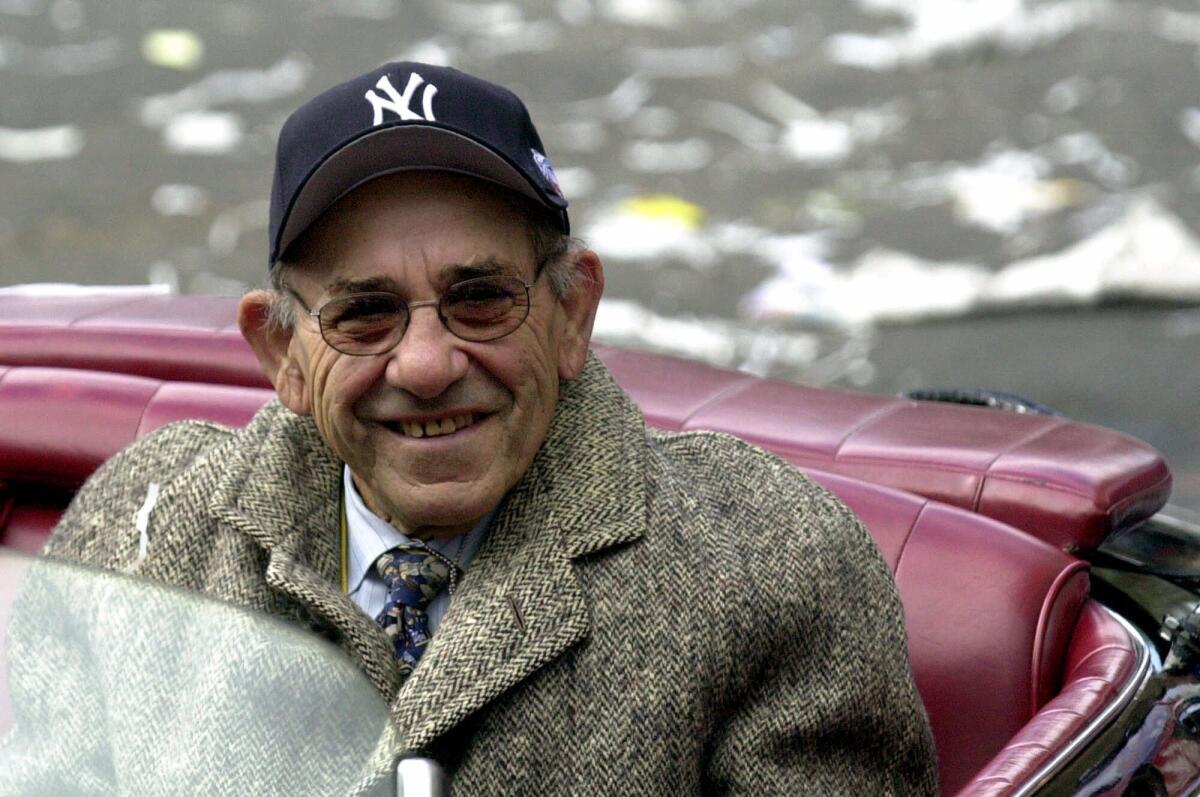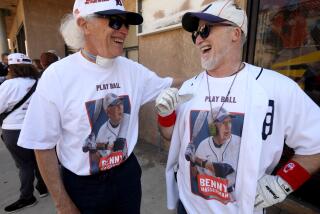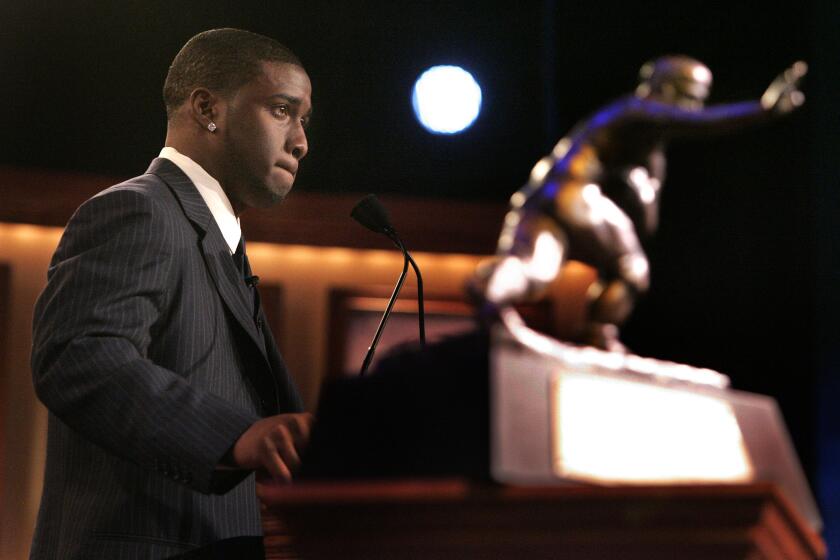Yankees Hall of Fame catcher Yogi Berra dies at 90

Yogi Berra rides in the Yankees World Series victory parade in 2000.
For the beloved sports figure who said, “It ain’t over ‘till it’s over,” it’s sadly over.
Yogi Berra, 90, the Hall of Fame catcher with the dynastic 1950s New York Yankees known for his absurdly profound “Yogi-isms,” died Tuesday of natural causes at an assisted living facility in Montclair, N.J., said Dave Kaplan, founding director of the Yogi Berra Museum and Learning Center.
Berra’s death came on the 69th anniversary of his major league debut as a player.
Fans are in awe of great players, and Berra was a star among stars on those powerful Yankees teams with Mickey Mantle, Phil Rizzuto, Billy Martin, Whitey Ford, Don Larsen and Roger Maris.
But it went well past awe to true affection for the genial Berra, whose wacky public utterances — spoken with utter sincerity — were quoted by presidents, professors and public speakers of all stripes, among millions of others.
Among the favorites:
“When you come to a fork in the road, take it.”
“Never answer an anonymous letter.”
“You can observe a lot by watching.”
“We made too many wrong mistakes.”
“It’s deja vu all over again.”
“The future ain’t what it used to be.”
“Always go to other people’s funerals, otherwise they won’t come to yours.”
It was long believed that some New York sportswriters dressed up or made up Yogi-isms to make their stories better. Asked about it, Berra simply added another Yogi-ism, replying, “I really didn’t say everything I said.”
Yogi Berra’s Most Memorable Quotes
President Obama, in a statement Wednesday, described Berra as a “jovial prophet.”
“He epitomized what it meant to be a sportsman and a citizen, with a big heart, competitive spirit and a selfless desire to open baseball to everyone, no matter their background,” the president said.
If he hadn’t been a ballplayer, though, no one would ever have heard what he had to say. Nor would anyone have seen this fireplug of a guy from St. Louis work his way into the American consciousness to the point that a TV cartoon character — Yogi Bear — was named after him. He also was frequently featured in TV commercials for a variety of products, including beer, potato chips, a fast-food chain and cat food. His most noted spot as a pitchman was for the insurance company Aflac that first aired in 2002 and co-starred him with a duck.
But first and foremost, Berra was a ballplayer, known for his hustle, his adroit handling of temperamental pitchers, his clutch hitting and his running commentary to batters while he was behind the plate. He also was known as a stabilizing influence on a team of revelers.
Casey Stengel, Yankees manager during much of Berra’s career in New York, ranked him second only to Joe DiMaggio among the best players he had managed.
A baseball “lifer,” Berra stayed with the game well into his 60s after completing his distinguished 19-year playing career, serving two stints as manager of the Yankees and one as manager of the New York Mets — he also played his last season with them. He also was a coach with both of those teams, and the Houston Astros as well.
Berra, who hit a home run in his first major league at-bat, was honored as the American League’s most valuable player in 1951, ’54 and ‘55, played in 14 World Series — the Yankees won 10 of those — coached or managed in seven more, and was voted onto the American League All-Star team 15 times and into the Hall of Fame in 1972.
He hit better than .300 in four seasons, had 11 seasons with 20 or more home runs, and five with at least 100 runs batted in. Behind the plate, he called three no-hitters, most famously Larsen’s perfect game in Game 5 of the 1956 World Series against the then-Brooklyn Dodgers. That game ended, with the Yankees ahead, 2-0, on a called third strike. Berra, still wearing his catcher’s mask, ran to the mound and jumped into Larsen’s arms, providing baseball with one of its most enduring photographs.
Lawrence Peter Berra was born May 12, 1925, in St. Louis. His father was a bricklayer from Milan, Italy, who came to the U.S. in 1909.
“He got off in New York,” Berra told the Bergen County Record in 2009. “They said there’s a job in St. Louis, and he said, ‘I’ll take it.’ Then he sent for my two older brothers and my mother.”
Berra grew up playing any number of sports in the Italian neighborhood everybody called “the Hill.” Known as Lawdie, his mother’s pet name for him, he and his brothers liked everything athletic but were passionate about baseball. Their immigrant father saw that as a waste of time, however, and sent each of the boys out to work early in life so they could help with family expenses during the Great Depression.
Going no further in school than the eighth grade, Berra went to work in a coal yard, drove a delivery truck and worked in a shoe factory. Always, though, he had his mind on baseball.
“I always said, when I was 14 years old, I’m going to play in the big leagues,” Berra said in a 2012 NPR interview.
With the support of his brothers, he persuaded his father to let him pursue a career in the sport. He played mostly as an outfielder on an American Legion junior team, and picked up his famous nickname. “I was sitting on the ground,” he told NPR. “I sit on the ground and I always had my arms crossed. And Bobby Hofman played with the Giants. He saw me, said, ‘You look like a yogi,’ and it stuck.”
Berra and boyhood pal Joe Garagiola tried out in 1942 with the hometown Cardinals, whose general manager at the time was Branch Rickey.
Garagiola was signed for a $500 bonus. Berra was offered a $250 signing bonus but turned it down, figuring he was worth more. Rickey disagreed, predicting that Berra would never amount to much as a baseball player.
Berra signed the next year with the Yankees for a $500 bonus and was sent to the minor league Norfolk Tars, where he became an error-prone catcher but showed promise as a hitter. He was promoted to the Yankees’ Kansas City farm team in 1943 but joined the Navy instead and served as a gunner’s mate during the D-day invasion of Normandy. During the fighting, it’s said, he earned a Purple Heart but refused to accept it because he didn’t want to alarm his mother.
Back in baseball after World War II, he was sent to the Newark Bears for the 1946 season, then was called up late in the season by the Yankees. He struggled in his first few seasons, swinging at bad pitches and developing a reputation as a wild-armed catcher, a player who was frequently “hidden” in the outfield.
At one point, he was advised to think when he went up to the plate and swing only at good pitches. Berra took the advice to heart on his next at-bat, promptly struck out and stormed back into the dugout, muttering, “You can’t hit and think at the same time!”
When Stengel took over as manager in 1949, he brought in Bill Dickey, a fabled Yankee catcher in the 1930s, to work with Berra. Under Dickey’s tutelage, Berra blossomed, both as a catcher and a hitter, becoming so confident behind the plate that he began talking to hitters, and others who happened to be around home plate.
“Personally, I talk to everyone,” he wrote in a first-person story that appeared in the Los Angeles Times in 1956. “I talk to umpires. I talk to my pitcher. And, most of all, I talk to the hitters — all of them, that is, except guys fresh up from the minors. Rookies have to put all their concentration on the pitch, so I carefully avoid chewing the fat when they come to bat.
“But a veteran should be able to take some conversation, even a little ribbing, in his stride. So I’ll bend his ear, no matter how tense the situation.”
According to Berra, only Boston Red Sox slugger Ted Williams ever told him to shut up. Berra said he went right on yakking.
As a hitter, Berra held the distinction of leading the Yankees in runs batted in for seven consecutive seasons, from 1949 to 1955, when DiMaggio and Mantle otherwise dominated the lineup. And in five seasons, he had more home runs than strikeouts.
His love affair with baseball almost ended on a sour note when Yankee owner George Steinbrenner fired him as manager 16 games into the 1985 season. Berra said he understood the firing but took issue with Steinbrenner sending someone else to break the bad news.
Berra boycotted Yankee Stadium, and all things Yankee, until 1999, when Steinbrenner apologized and asked him to throw out the first pitch at the season opener. He was also honored that season with a Yogi Berra Day at Yankee Stadium.
That was not the first Yogi Berra Day. They had one for him in 1959 at Yankee Stadium and another in St. Louis in 1947, when as a Yankee rookie he was in town for a game against the old St. Louis Browns.
After having been announced as a hometown boy made good, Berra responded, “I want to thank everybody for making this day necessary.”
Berra’s wife of 65 years, Carmen, died last year . He is survived by their sons Larry, Tim and Dale; 11 grandchildren and one great-grandchild.
Kupper is a former Times staff writer.
SIGN UP for the free Dodgers Dugout newsletter >>
More to Read
Get our high school sports newsletter
Prep Rally is devoted to the SoCal high school sports experience, bringing you scores, stories and a behind-the-scenes look at what makes prep sports so popular.
You may occasionally receive promotional content from the Los Angeles Times.







